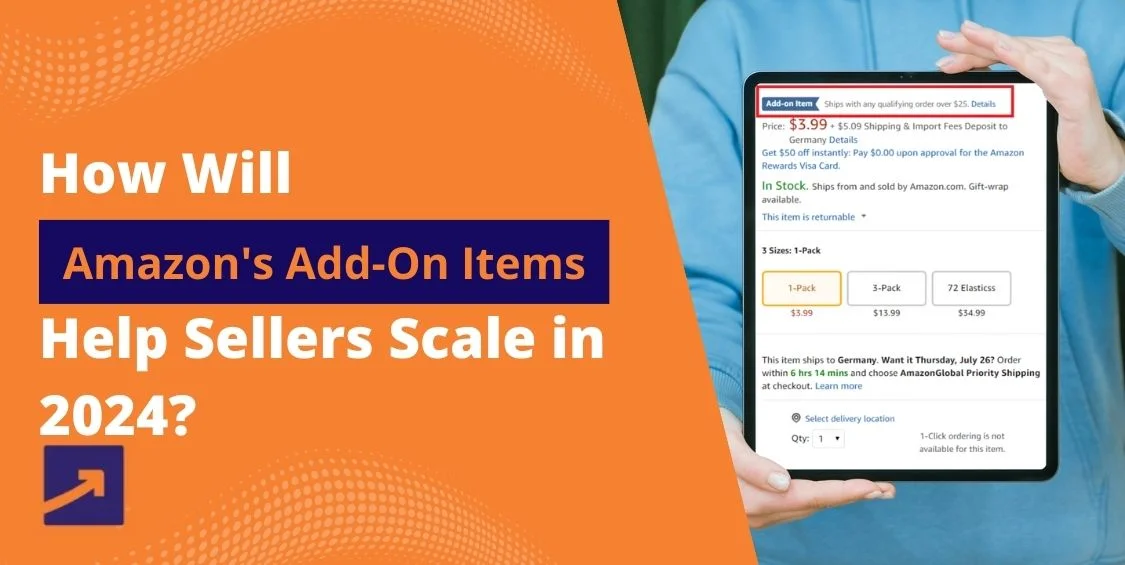Is the designation of your product as an “Amazon Add-On Item” something you, as a merchant, have noticed? This label can help your sales despite your best intentions if managed properly.
Read on as we break down Amazon’s add-on item rules and how it can affect you and other sellers. Above all else, we will provide you with some doable advice that will enable you to overcome the program’s obstacles and boost your average order value!
Amazon has become the preferred online shopping destination with its multibillion-dollar marketplace that provides choice and ease. Inevitably, Amazon’s numerous policies affect buyers and sellers in diverse ways due to its immense influence and power over the eCommerce business. The Amazon Add-on Item Program policy has been the most contentious among vendors.
Here, we’ll examine Amazon’s add-on Items, what they do, and how they influence sellers. Additionally, we will review real-world ways to get around this program’s limits and boost your average order value.
What Is Amazon’s Add-on Program?
Due to their low cost, add-on products are economical items that would be impractical to ship individually. These products vary widely, from spices like paprika to small fishing baits. Amazon’s Add-on feature enables them to offer such items to customers despite the challenges of shipping them individually.
The catch? These add-on items on Amazon can only piggyback on orders that reach a minimum value and include items shipped directly by Amazon. This ensures efficient delivery for everyone.
To enhance the shopping experience, Add-on items are clearly labeled with an “Add-on items” badge throughout the shopping journey. However, because of the dynamic nature of the market, sellers aren’t notified when items are included or removed from the program. An automated system assesses items daily, resulting in frequent changes to the list of Add-on items.

On top of that, there are restrictions on buying extras. That encompasses:
- Adding only optional extras will not fill a cart.
- If your total does not reach $25, Amazon holds all of the extras buyers add to their cart to buy.
- To reach the $25 mark, buyers must include Amazon Fulfillment items.
Snacks, personal hygiene products, and office supplies are just a few examples of products with these restrictions, which may be inconvenient for consumers and businesses.
What Makes Amazon’s Add-on Items Valuable For Sellers?
To reiterate, expanding the listed product collection is the primary objective of the Amazon Add-on Item Program. Customers can save money on shipping and access more low-priced product categories if encouraged to add more things to their cart. With Amazon’s add-on items, customers can compete with other online shops that provide low-priced items without requiring a minimum order value.
Additionally, this approach is influenced by Amazon’s emphasis on customer satisfaction. They may ensure that customers get the most out of their money and prevent disappointment or bad reviews caused by expensive shipping, deterring them from buying the lowest-priced items. No one wants to pay $35 for a $1 Liquid Soap.
This strategy can be considered fair or detrimental to vendors, depending on what you sell. While this can be a boon for sellers looking to boost their average order value, it could also damper sales for some product types. Consider that the decision to classify an item as an add-on is based on more than just the product cost; it also considers shipping costs and competitive pricing on other platforms.
5 Benefits Of Amazon’s Add-On Items For Sellers:
As an Amazon seller, you must wonder whether this add-on feature benefits sellers like me. The answer is Yes, it does! By offering add-on products, you may raise your average order value and, by extension, your revenue.
Here are some apparent benefits of Add-on items for Amazon sellers:
1. Better opportunities for cross-selling and upselling: By introducing complementary items, you can entice customers to expand their shopping carts, amplifying the potential for larger transactions.
2. Instill buyer confidence with the add-on badge: The presence of this badge serves as a reliable indicator for purchasers, who are more inclined to perceive products bearing it as credible and dependable, thus potentially boosting conversion rates.
3. Diversify the range of offered products: For items that fall below the eligibility criteria for the program, consider bundling them with other products or offering them as incentives to meet the minimum $25 requirement, thereby broadening your assortment.
4. Use it as an added value to your popular product: In cases where supplementary items complement your primary product but may lack independent appeal, consider offering them as bonuses alongside the main purchase to heighten its perceived value.
5. Contribute to eco-friendly practices: By bundling low-cost items with larger orders, you can effectively minimize packaging waste and transportation emissions, thereby playing a part in promoting a more sustainable shipping process.
How To Remove Unwanted “Add-On Item” Badge From A Listing?
It may be possible for some sellers to experience drawbacks more than benefits of the “Add-on Item” badge on their listing. However, lucky for such sellers, like many Amazon Badges, like “Best Seller” or “Amazon Choice,” this “Add-on Item” badge is not permanent.
You can do a few things to remove your product’s “add-on” label if you don’t want it to be. However, remember that Amazon’s badge awards standards can change often, so it’s hard to say when the badge will be removed. The next day, it can be gone and then back again.
- Carefully raise the price of your product to which still makes sense for the product. You can use relevant tools like Amazon Price Elasticity Calculator to determine the new price.
- Offer these low-priced items as bonuses or value-added items with more expensive items in your store, such as a makeup pouch with a makeup kit.
- Bundle relevant low-cost items together, such as a jar of spice with a pack of paprika, liquid surface cleaner with a microfiber cloth, etc.
- Another way to create a low-cost add-on items bundle is by multiplying it, such as a pack of 2 shampoos, 5 tubes of toothpaste, 4 handwash, and so on. This will help you increase the overall order value, save shipping costs, and make inventory more manageable.
- For a guaranteed shot to remove the add-on item badge, switch from FBA to FBM, as Amazon does not add the label to products that aren’t in the FBA program.
Key Takeaway About “Add-on Items” For Amazon Sellers:
Amazon’s add-on items will ultimately hit sellers whose products are primarily lightweight and at the lowest price (ideally under $25 or less). Getting the “add-on” label isn’t the be-all and end-all. We’ve mentioned five tips to help sellers remove the “Add-on Item” label from their listing.
Whether new to Amazon or an established seller struggling with adjusting pricing, combining products, or changing fulfillment techniques, our experts can help!
At AMZDUDES, we want to see Amazon sellers thrive in intense competition, so we provide tailored solutions to achieve your brand’s goals. Contact us today to find out how we can assist your company in becoming successful on Amazon, or book a consultation with our seasoned experts for one-on-one, in-depth consulting.





